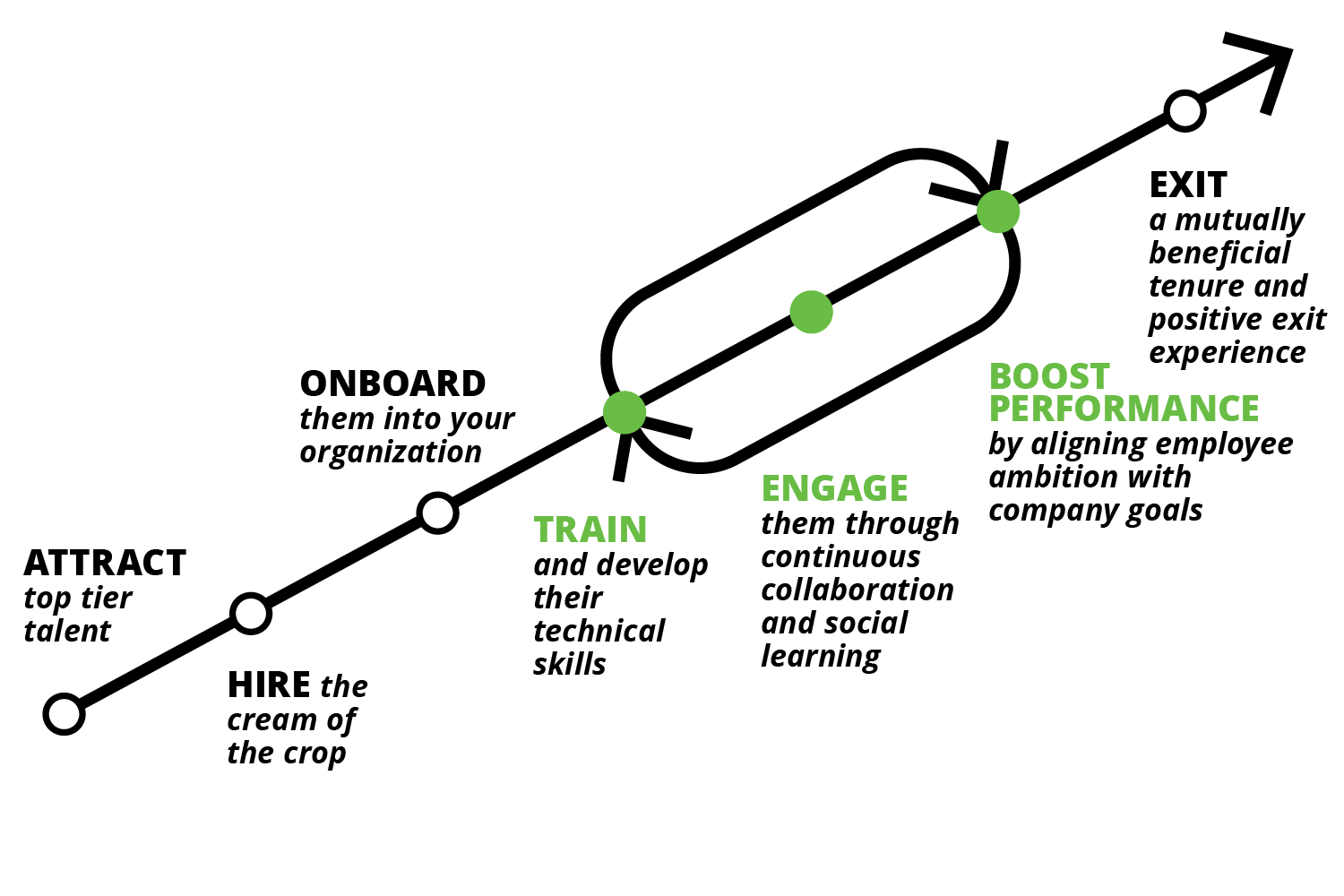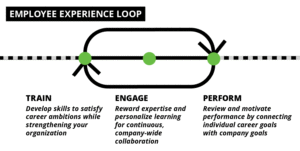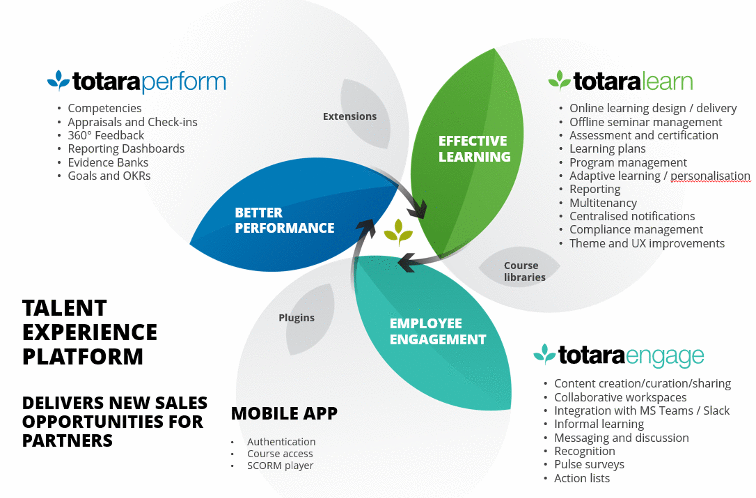Choosing the wrong technology to improve employee experience can cripple your organization’s productivity.
Many HR leaders and managers fall prey to opting for employee engagement tools predicated on perfunctory perks, assuming they are sustainable solutions that drive employee engagement and performance—they’re not.
Can these tools contribute to a high-performing workplace or generate an (often temporary) uptick in engagement? Yes. There’s no denying that.
Transformational and sustained change, however, occurs within a workplace that addresses the most critical aspects of employee experience (we call this talent experience here at Totara) by:
-
Developing the skills of employees
-
Nurturing collaboration and knowledge sharing between teams
-
And aligning employee goals with organizational objectives
Choosing technology that addresses these essential elements of the employee experience fosters a powerful, collaborative growth culture that allows any organization to adapt to change and empower its employees.
In this post, you’ll get a breakdown of the best workplace tools for empowering a great employee experience and building an adaptive, aligned and high-growth culture.
Table of contents:
-
The difference between talent experience and employee experience technology
-
3 ways to use technology to improve employee experience
#1: Invest in a better learning management system
#2: Encourage knowledge-sharing and collaboration
#3: Use people-centric performance management technology -
The all-in-one solution for an unbeatable employee experience
Talent vs employee experience technology: What’s the difference?
Employee experience is a broad definition of an employee’s perception of their workplace as it relates to their experiences and touchpoints throughout the employee lifecycle.
Technology focused on improving the employee experience could therefore encompass anything from job candidacy to daily experiences, relationships with management, engagement, reimbursement, culture, rewards and much more.
Given the ambiguity of the term “employee experience”, here at Totara, we use the term talent experience to cover the practical (and most influential) everyday aspects of employee experience that influence employee engagement. These are:
-
Learning and development: In addition to mandatory compliance training, are employees getting better at their craft or learning the skills they need to develop and progress in their careers? Are they learning the skills that will benefit your organization in the future?
-
Enabling engagement and collaboration: Are employees able to collaborate and communicate with each other effectively? Can they find the hidden experts in the business that may already have solutions to problems they face? Can they learn what they need to, at the time of need, in the flow of work ?
-
Performance and mentorship: Is your performance management process personalized to the needs of the individual? Are you providing continuous and timely feedback? Do employees understand how their day-to-day roles contribute to their individual, team and ultimately the organization’s overall business goals?

Focusing on these foundations and the technologies that support them, as opposed to the shiny, but short-shelf-life initiatives that many still focus on (such as eccentric perks), yields a lasting ROI and unlocks an exceptional employee experience that fuels exceptional organizational performance.

3 ways to use technology to improve employee experience

While we mention specific workplace technologies for improving employee experience, the suggestions below are based on the three foundational talent experience “elements” they improve:
-
Corporate training and developing employees
-
Nurturing a collaborative culture
-
And ensuring that performance management practices align employee and organizational goals
Improving your organization’s capabilities in any one of these facets strengthens your organization’s culture, and will therefore go a long way in ensuring that you build an exceptional employee experience.
Speaking of culture, technology helps to amplify and extend your company’s culture; it can’t replace it. Investing in the right employee experience technology is a giant leap forward, but the culture your organization fosters must lead any initiatives to inspire meaningful change.
At a basic level, this means that employees should be encouraged to embrace a connected culture of learning, innovation and continuous growth. Managers should be comfortable practicing a more open or agile performance management approach that encourages frequent feedback and honesty from employees.
With that said, let’s explore the best ways to use technology to improve employee experience in your organization:
#1: Invest in a better learning management system
The learning management system ranks as one of the best technologies to improve employee experience for two reasons:
-
Today’s top tier employees crave mastery
-
Digitalization is driving more demand for competitive skills
When choosing a company to work for, nearly 87% of candidates rank learning and development opportunities in the workplace as critical.
Research also shows that high-quality training increases employee engagement because it influences “psychological variables” such as:
-
Motivation
-
Commitment
-
Organizational trust
For smart organizations, investing in learning and development resources, like an open-source LMS transcends typical tick-the-box compliance and regulatory training.
Rather than being regarded as a running cost of being in business, learning technology enables the organization to close skills gaps, create an adept, adaptable workforce, improve employee development plans and strengthen the skills of employees—which can generate a 14-29% increase in profit .
#2: Encourage knowledge-sharing and collaboration
When Mitchells & Butlers, the umbrella brand for over 1,700 pubs, cultivated a collaborative environment using Totara, it boosted engagement, performance and business outcomes. Compliance rates reached 89% and food quality scores increased by 5% across the board.
A learning experience platform (LXP) is a powerful way to improve employee experience with technology because it nurtures collaboration, mentorship and employee development that can support employees at every stage of their careers.
Suggested read: LMS vs LXP: Which one do you really need?
From brand-new employees to experienced senior management, an LXP connects people with similar learning needs—whether that’s by role, location, seniority level or skill set.
Not only will this help your people share knowledge, collaborate on projects and communicate with colleagues, but it also opens up the opportunity for developing employees to be mentored by senior experts.
Experts can curate training resources from multiple channels to create personalized development paths, answer questions from mentees and track how engaged mentees are.
This provides employees a dedicated place to develop their skills, discuss ideas with colleagues and solve problems together in an engaging and interconnected way.
#3: Use people-centric performance management technology
Enhancing employees’ skills and nurturing a collaborative culture will drastically improve the employee experience that your organization offers, but there’s a missing final link in the talent experience chain that prevents peak organizational performance:
Effective performance management.
Even if your employees are equipped with the right skills and are well-connected with colleagues, achieving alignment and getting employees to care about your organization’s mission becomes difficult if they:
-
Have a dysfunctional or poor working relationship with management
-
Are uncertain about their ability to progress their career
-
Don’t have a way to voice work-related concerns
-
Feel mismanaged or mistreated
Supported by a people-centric management culture, a performance management system completes the talent experience chain—addressing the most impactful elements of employee experience, and unlocking sustained employee engagement and alignment within your organization.
When choosing a performance management system to improve employee experience, we recommend flexible technology (like Totara Perform ) that supports both a traditional and agile approach and allows you to gradually improve your processes with features such as:
-
Continuous 360-degree feedback
-
Support for frequent check-ins
-
Up to date competency frameworks and skills audits
-
Clear objectives and goal-setting at all levels of the organization
Introducing the Totara Talent Experience Platform: The all-in-one technology for employee experience
Here at Totara, we built the Totara Talent Experience Platform to unite all the employee experience technology you need in one solution.
Comprising three solutions—that are powerful on their own, but transformational when used together— Totara’s Talent Experience Platform helps you build a better workplace, increase resilience and prosper in today’s fast-changing world. It unites:
1. Totara Learn – the adaptive LMS trusted by millions of learners and favored by companies worldwide (like Samsung and Indeed) to deliver transformational learning.
2. Totara Engage – the learning experience platform (LXP) built to engage, unite and upskill your workforce. Totara Engage empowers employees to simplify complex knowledge sharing with collaborative workspaces and Microsoft Teams integration, to deliver higher employee engagement.
3. Totara Perform – with flexibility, organizational control and performance management at its core, Totara Perform cultivates peak employee productivity.

Together, these intuitive systems (that integrate with your current HCM and L&D tech) empower you with a talent experience platform that improves every aspect of your employee-employer experience to unlock peak performance and boost agility in your organization.



